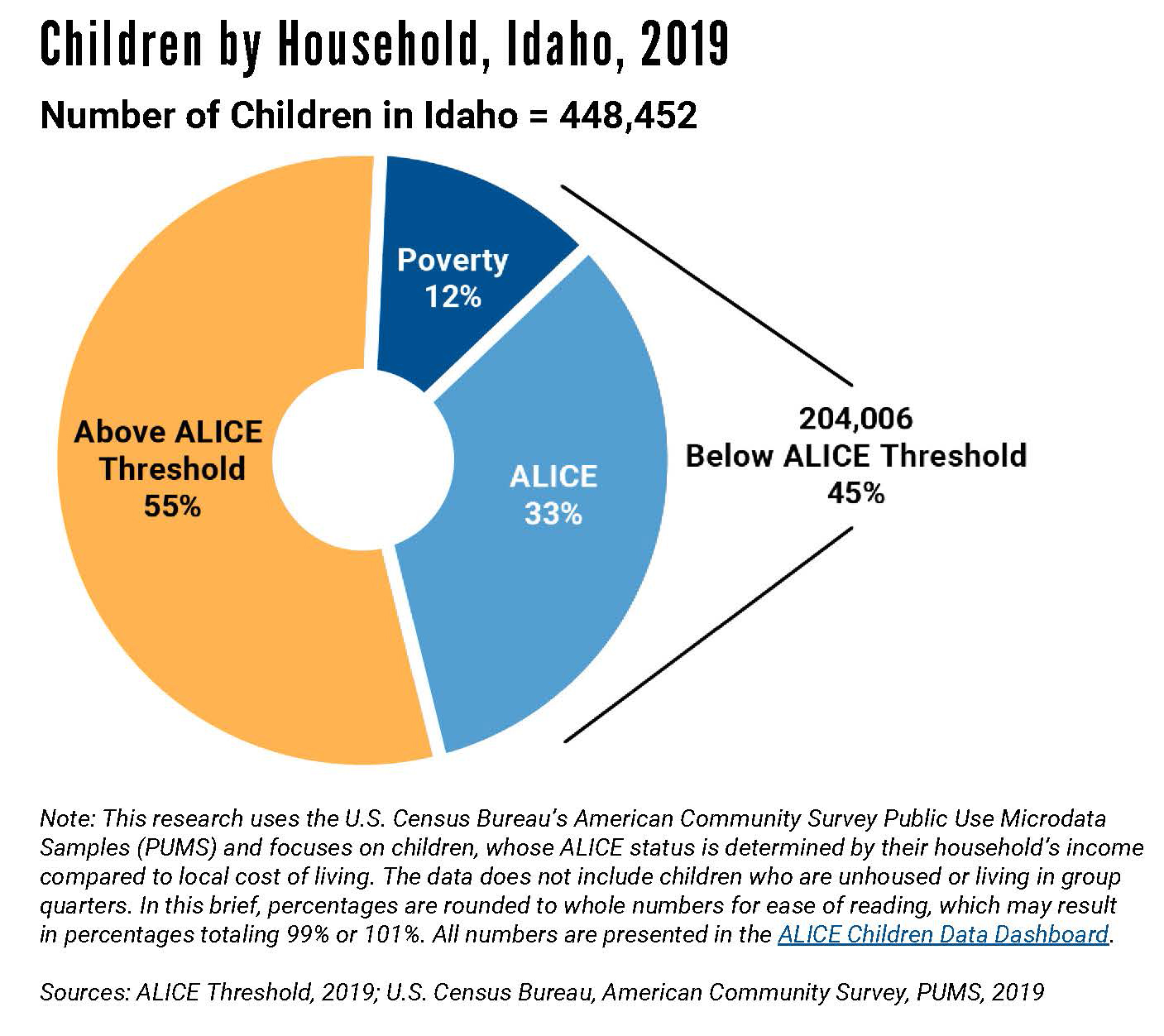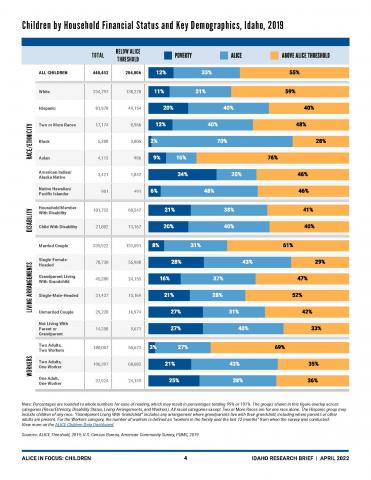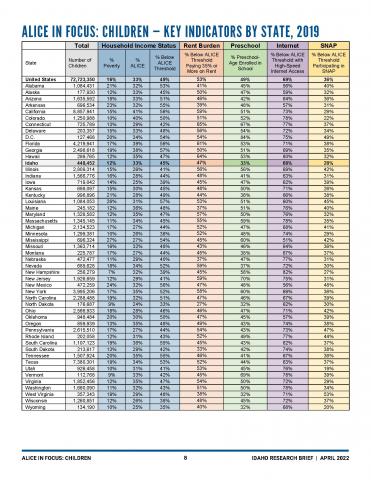
CHILDREN IN FINANCIAL HARDSHIP:
IDAHO
The number of children growing up in financial hardship in Idaho has been systematically undercounted. For decades, policymakers and community stakeholders have relied on the outdated Federal Poverty Level (FPL) to understand the extent of financial hardship in their communities. According to the FPL, 12% of children in Idaho (55,877) lived in poverty in 2019. Yet United For ALICE data shows that another 33% (148,129) — nearly three times as many — were also growing up in hardship, in households that earned above the FPL but not enough to afford the basics in the communities where they lived.
The reality is that 204,006 children in Idaho — 45% of all children — lived in a household with income below the ALICE Threshold of Financial Survival in 2019. These households included families in poverty as well as those who were ALICE: Asset Limited, Income Constrained, Employed. ALICE households don’t earn enough to afford the essentials of housing, child care, food, transportation, health care, a smartphone plan, and taxes — the basics needed to live and work in the modern economy. There are children below the ALICE Threshold in communities across the state (PUMAs), at rates ranging from 33% in southern Ada County (southern Boise and Kuna cities), to more than 50% across the areas surrounding the city of Idaho Falls.
WHO ARE ALICE CHILDREN?
Children below the ALICE Threshold are those under age 18 living in households with income below the basic cost of living for their communities. In 2019, 19% of children below the ALICE Threshold in Idaho were infants (0–2 years), 13% were preschool-age (3–4 years), and 68% were school-age (5–17 years). Children in Idaho’s struggling households are from all demographic groups; they include children born in the U.S. and abroad, of all abilities and races/ethnicities, living with parents or guardians who are married or single, working or not working. Children in households below the ALICE Threshold live in rural, urban, and suburban areas across the state.
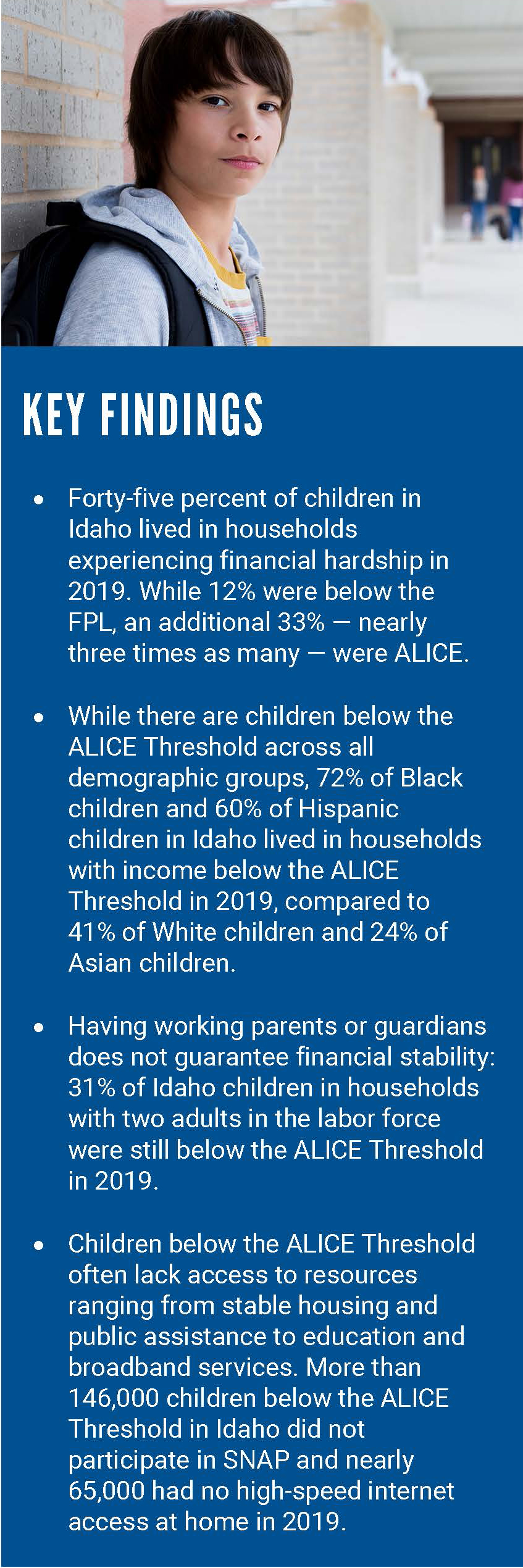
In 2019, the largest number of children below the ALICE Threshold in Idaho were found in the largest racial/ethnic populations: Children below the Threshold were predominantly White (138,270) and Hispanic (49,154). Yet Black and Hispanic children are disproportionately represented among ALICE children — a result of persistent discrimination and systemic barriers that limit their families’ access to resources and opportunities for financial stability. In 2019, 72% of Black children, 60% of Hispanic children, and 54% of American Indian/Alaska Native children in Idaho lived in households below the ALICE Threshold, compared to 41% of White children and 24% of Asian children.
Nativity and English-speaking ability also have an impact. Of the 3,797 children in Idaho who were born outside the country (1% of children in the state), 56% were below the ALICE Threshold in 2019, compared to 45% for those born in the U.S. Rates were even higher for Idaho children living in a family with limited English-speaking ability, with 71% below the Threshold (compared to 84% nationally).
In 2019, there were 21,802 children with a disability in Idaho — 5% of all children in the state. However, this is likely a significant underestimate as the number of children being served under the Individuals with Disabilities Education Act in the state is substantially higher. Children with a disability were more likely to live in households below the ALICE Threshold (60%) than those without a disability (45%). The most common disability, impacting 15,504 children age 5 and older, was a cognitive difficulty due to a physical, mental, or emotional issue — having trouble remembering, concentrating, or making decisions.
Having a household member with a disability affects everyone in the family. In 2019 there were 101,723 children in Idaho living in a household where someone had a disability, and 59% were below the ALICE Threshold. When a parent or guardian had a disability, children were more likely to be below the Threshold, at 64%.
ALICE children live in all kinds of households — with married or unmarried parents, single parents, grandparents, or guardians. Children are more likely to be below the ALICE Threshold when their families have fewer adults and/or adults with lower earning potential due to systemic racism and gender and age discrimination.
Most children in Idaho (95%) lived with at least one of their parents (biological or adoptive) in 2019: 72% lived in a household with both parents and 23% in a household with one parent. The largest number of children below the ALICE Threshold were in married-couple households (131,591), yet this group had the smallest share of children below the Threshold (39%). The next largest group — single-female-headed households (55,988) — had a much higher percentage of children below the Threshold at 71%. Other arrangements had lower but still substantial percentages of children in struggling households: 58% of children in unmarried-couple households and 48% of children in single-male-headed households were below the Threshold.
In 2019, 10% of Idaho’s children (45,280) lived in a home with a grandparent. Children living with grandparents were more likely to be below the ALICE Threshold than those living without a grandparent (53% vs. 45%).
In addition, there were 18,816 children in Idaho living in households without their parents in 2019. Six percent of these children (1,105) were in foster care (compared to 7% nationwide). But many more children who lived without their parents were in arrangements outside of the formal system, including households headed by a grandparent or other relatives (13,139) or by nonrelatives (4,572). More than half (60%) of children living without their parents in Idaho were below the ALICE Threshold, just under the national rate (62%).
The largest number of children below the ALICE Threshold living without their parents were White. Yet a higher percentage of Black or Hispanic children living without their parents were below the Threshold (75% and 81%, respectively), compared to those who were White (53%).
The largest driver of a child’s financial stability is the employment status of household members. In 2019, most children in Idaho lived in a household with at least one worker (97%). But having working parents or guardians does not guarantee financial stability.
Children living with two adults were more likely to be financially stable than children living with a single parent or guardian. Yet even in households with two working adults, 31% of children were below the ALICE Threshold. When only one of two adults worked, the rate increased to 65%. Children living in a household with a single working parent or guardian were even more likely to be below the Threshold (64%).
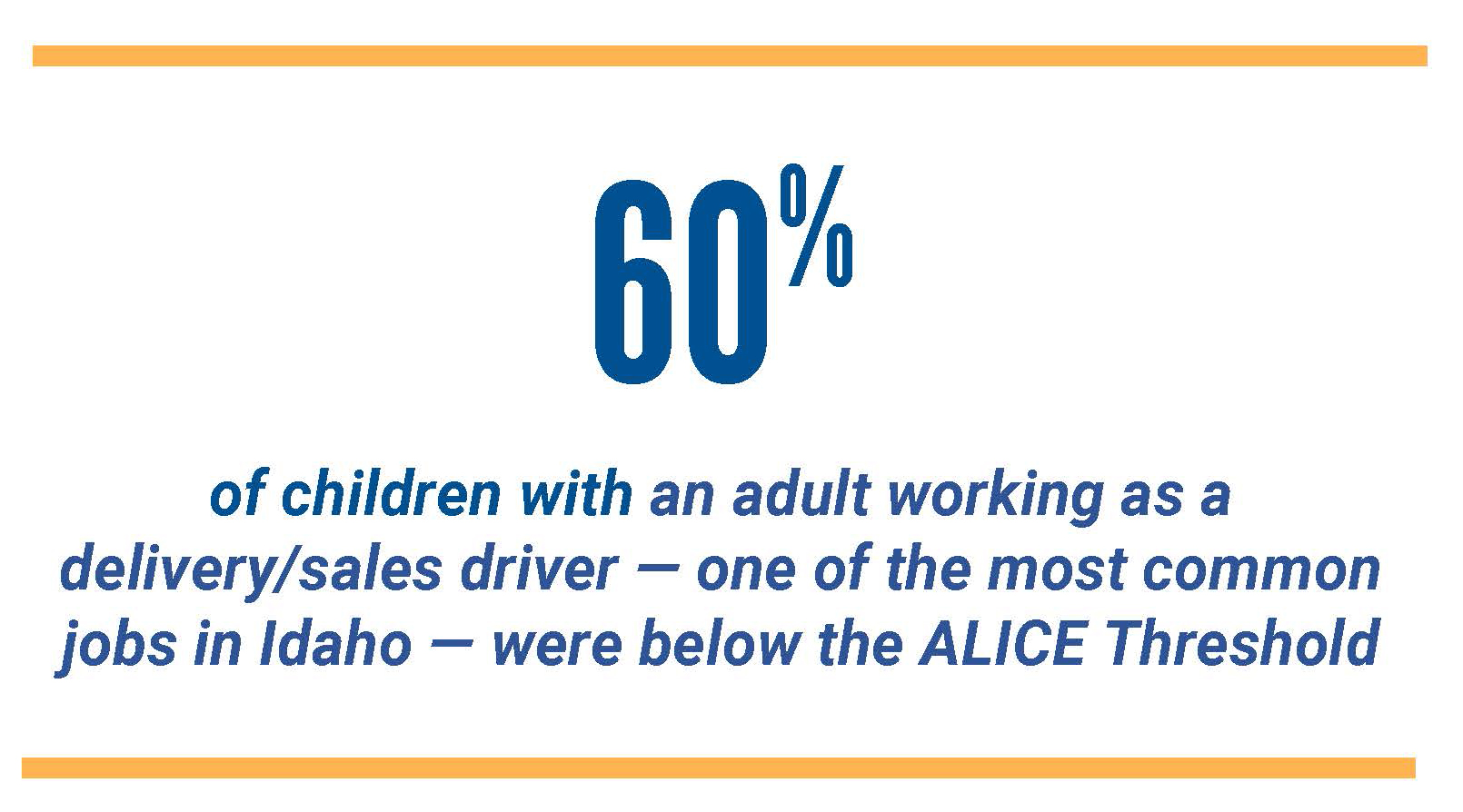
While parents and guardians work in every industry and sector in Idaho, children below the ALICE Threshold are concentrated in families where adults work in occupations with low median hourly wages. For example, in 2019, 60% of children with an adult working as a delivery/sales driver, earning a median wage of $11.77 per hour, were below the Threshold. Similarly, 57% of children with adults working as a customer service representative (median wage of $15.39 per hour) were below the Threshold. Even more striking, 81% of children with an adult working as a cashier (median wage of $10.81 per hour) were unable to afford the basics.
Even among children with an adult working in a slightly higher-wage job, such as a retail sales supervisor (median wage of $19.10 per hour), 45% were below the Threshold, as household expenses vary by household size, composition, and location.
In addition, 33% of 16- and 17-year-olds in Idaho (15,324) were in the labor force in 2019. Of teens living in households with income below the ALICE Threshold 31% were in the labor force, compared to 34% living in households above the Threshold. While these findings may seem counterintuitive, they are in line with existing research that shows youth in low-income households have fewer opportunities and resources needed to work than teens from families with higher incomes.
WHAT RESOURCES DO ALICE CHILDREN LACK?
Many ALICE families earn too much to be eligible for public assistance but still struggle to meet basic needs for their children. ALICE households are much more likely to lack stable housing, quality child care/early education, private health insurance, and home internet access, yet they still don’t qualify for many public assistance programs. When these necessities are at risk, there are both short- and long-term consequences for children below the ALICE Threshold.
Housing instability has a profound impact on a family and child’s overall well-being. Children in families without stable housing face greater risks for poor physical health, increased family stress, social isolation, and lower academic performance. Children living in rented housing units and cost-burdened households are more likely to go through the stress of moving — and ALICE children and children in poverty are more likely to live in both of these types of housing.
Among children below the ALICE Threshold in Idaho in 2019, 41% were in families who rented and 59% were in families who owned their home (vs. 13% and 87%, respectively, for households above the Threshold). There were also gaps by race and ethnicity both above and below the Threshold. Below the Threshold, families of Asian children had the lowest homeownership rate (33%), while families of White and Black children had the highest rates (at 62% and 65%, respectively). Above the Threshold, families of White and Hispanic children had the highest rates (at 88% and 89%, respectively) and families of Black and American Indian/Alaska Native children the lowest (at 49% and 43%, respectively). These trends in Idaho differ from national average homeownership rates for households with children, which show the lowest rates for families of Black children and the highest rates for families of White children, regardless of income.
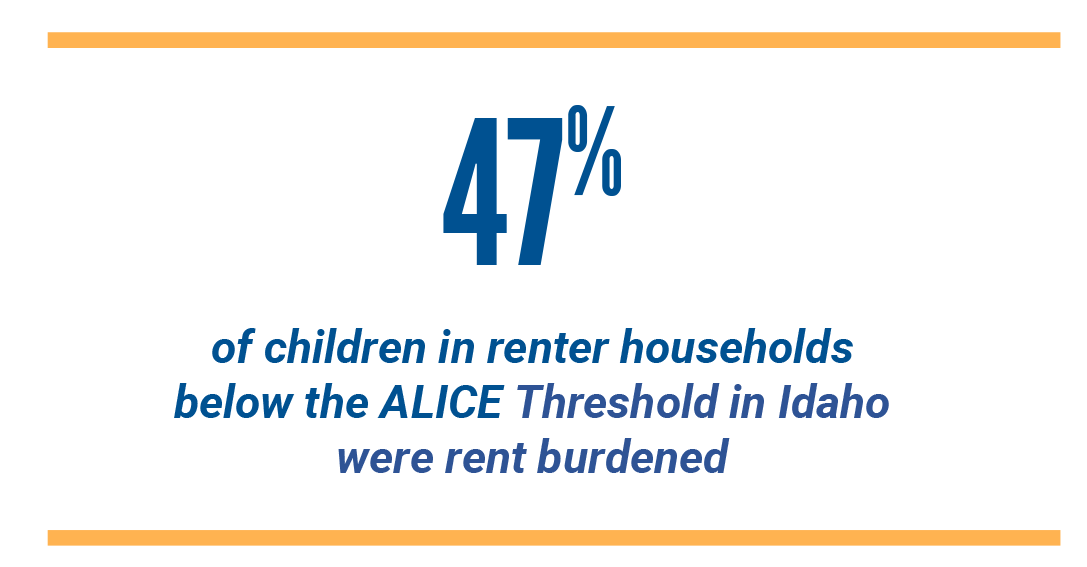
Because housing is one of the most expensive items in the Household Survival Budget, it is not surprising that 47% of children in renter households below the ALICE Threshold in Idaho paid more than 35% of household income on rent (compared to 6% of children in renter households above the Threshold). The highest rates of children below the Threshold living in rent burdened households (73%) were in northeast Ada County (including northern and western Boise and Garden City).
For all children — regardless of whether their family rented or owned — the longer they lived at their place of residence, the more likely they were to have higher income. Both above and below the ALICE Threshold, children in renter households were more likely to have moved in the past year compared to those in owner households (30% vs. 11%).
Quality early-childhood programs have proven to be critical to healthy child development, and to acquiring foundational skills required for a successful transition to school and future academic achievement. Of all preschool-age children in Idaho, 33% were enrolled in preschool in 2019, lower than the national average (49%). Idaho had the lowest rate of children below the ALICE Threshold enrolled in preschool in the Pacific Northwest, and the second-lowest rate in the country. Preschool enrollment rates also differed by household financial status: 28% of preschool-age children below the ALICE Threshold in Idaho were enrolled in preschool in 2019, compared to 39% of their peers above the Threshold. A smaller difference was seen in kindergarten enrollment (80% of kindergarten-age children below the Threshold vs. 87% above).
Being a high school graduate prepares teens for future academic and career success. Yet in 2019, 1,992 Idaho children aged 15–17 were not in school. Over half of these teens (55%) lived in households with income below the ALICE Threshold.
Access to health insurance is critical to both wellness and financial stability for families below the ALICE Threshold and especially children. While most children in Idaho had health insurance in 2019 (96%, slightly higher than the national rate of 95%), 6% of children in families with income below the ALICE Threshold did not have coverage. Children in families with income below the Threshold were more likely to have public insurance (53%), while those above the Threshold were more likely to have private insurance (84%).
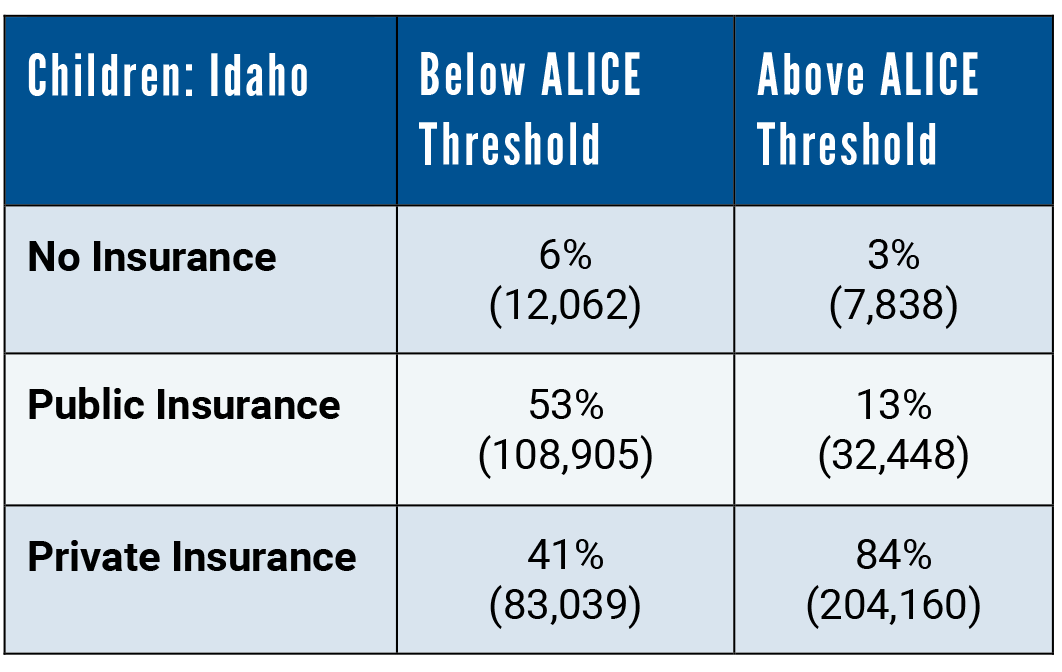
The availability of internet access and devices for education has become increasingly essential for young people, yet the digital divide by income and race/ethnicity persists. In Idaho, 96% of children overall had home internet access in 2019, slightly higher than the national rate (95%). However, children below the ALICE Threshold were less likely to have home internet access than those above the Threshold (94% vs. 98%) and considerably less likely to have high-speed internet (68% vs. 81%), which is often essential for work and online learning.
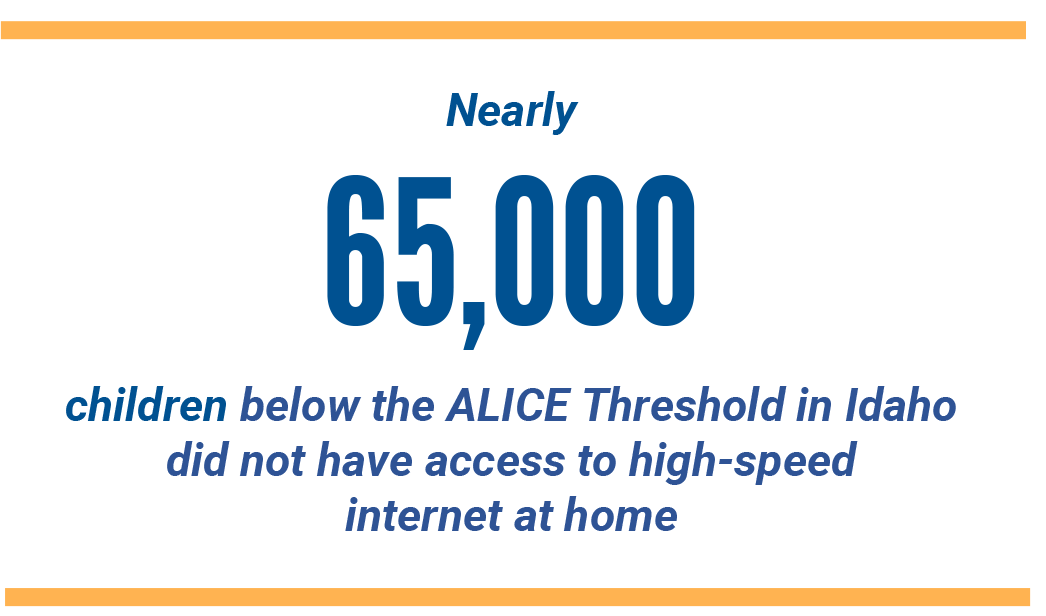
Access also varied by location. The percentage of children below the ALICE Threshold without high-speed internet access was highest across Blaine, Camas, Elmore, Gooding, Jerome, Lincoln, and Minidoka counties (at 47%).
For a variety of reasons, public assistance does not reach all children in households that are struggling. While most children in poverty are eligible, ALICE children live in households that often earn too much to qualify for assistance. For example, the income eligibility threshold in Idaho for one of the most far-reaching public assistance programs, the Supplemental Nutrition Assistance Program (SNAP, formerly food stamps), is 130% of the FPL. Even though all children in poverty should be covered by SNAP, in Idaho the program was utilized by only 48% of children in poverty (26,704) and a mere 21% of children in ALICE households (30,994) in 2019. This left a gap of just over 146,000 children whose families were struggling to make ends meet but not participating in SNAP.
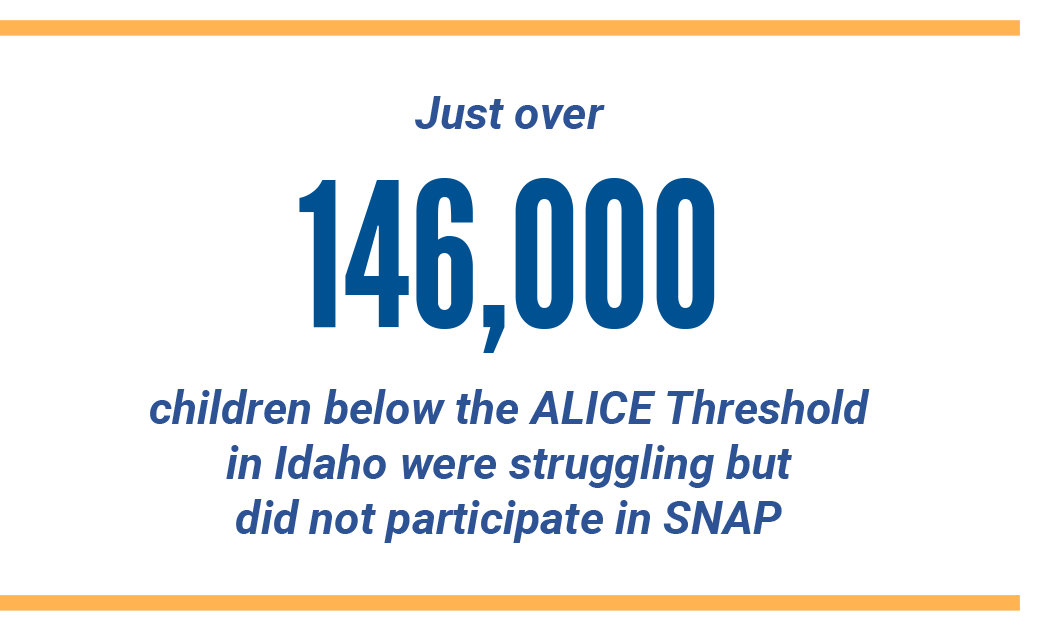
SNAP coverage of children below the ALICE Threshold varied among Pacific Northwest states: At 33%, Idaho had the lowest rate, compared to Washington (34%) and Oregon (38%).

